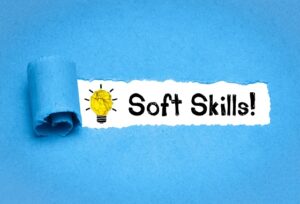Different research studies have shown that, the best performing corporates, individuals and groups are the ones who have been able to combine hard and soft skills effectively. It is key that as individuals who want to grow our careers, entrepreneurs who want to grow ourselves, and our businesses and organizational leaders that want to make an impact and leave a legacy of greatness; we must start investing in and developing our “soft skills”.
Research conducted by Harvard University, the Carnegie Foundation and Stanford Research Center has concluded that 85% of job success comes from having well-developed soft and people skills, and only 15% of job success comes from technical skills and knowledge (hard skills). This research finds its beginning with the work of Charles Riborg Mann from a Study of Engineering Education in 1918.
Our daily life activities involve a blend of processes, products and possibilities to create the perfect aroma, taste, look, or effect. But in critical spaces such as our organizations, entrepreneurial ventures, career and leadership journeys, we sometimes overlook the essentials needed to blend with the key technical capacities and capabilities available to us to create the best impact. The technical knowledge and skills of our Human Assets matter, but we need their attributes and attitudes also known as “Soft Skills ” to create the wholistic best versions of us and therefore our organizations, entities or personal brands.
These will reflect in some of the following scenarios:
- An exceptional finance person who can’t connect effectively when it comes to personal impact.
- A brilliant marketing person who cannot appear, behave or communicate as the brand.
- A highly competent leader who can’t engage and inspire by their presence. There are many gaps when it comes to body intelligence, emotional intelligence, and moral intelligence.
This can be a silent but open wound within the cultural thread of the space and whilst it may not always be obvious, it can be detrimental to the growth strategy. Soft skills, often known as people skills are skills that require constant and conscious nurturing to enable one interact with people. A few examples are team management, the art of persuasion and negotiation, building morale and team work; just to mention a few. Bruce Tulgan was not mistaken in his article, ‘Defining the Power of Soft Skills’ when he said “Soft skills are the source of a huge amount of power that is always right there hiding in plain sight—a tremendous reservoir of often untapped value—a secret weapon for any smart organization, team, leader, or individual performer”.
Many Executives have emerged as success stories of the power of soft skills because they served as examples. One of the key attributes of soft skills sited by many researchers as a need in every worker is Professionalism. Professionalism is one of the key basics for any leader and employee in this modern cooperate world. The ability to recognize, understand and manage one’s own emotions and to understand and influence that of others is the popular term, Emotional Intelligence created by two researchers, Peter Salavoy and John Mayer. What stands out in one’s ability to be professional is the skill to self-evaluate; regularly assessing one’s own thoughts, words, and actions against clear meaningful standards; and one’s own performance against specific goals, timelines, guidelines and parameters.
Another soft skill pertinent to the birth and growth of any individual in the working class is the art of Listening. An article by Katherine Noel of the Business Insider explained that the best communicators are not those only skilled in articulating their thoughts, they are also great listeners. Successful leaders should make time to listen to the ideas and thoughts of others. Listening involves giving the speaker undivided attention, taking notes of important points and being welcoming to their ideas. Listening can be done in 4 ways according to indeed.com.
The first kind, deep listening includes paying attention to verbal and non-verbal cues to gain a full understanding of the speaker’s experiences, thoughts, feelings and objectives.
The second kind of listening is full listening that involves trying to fully comprehend the practical content of a speaker’s message. This type of listening often involves active listening skills, like paraphrasing and asking clarifying questions. Full listening can be particularly helpful when interpreting directions, learning new material, or developing new skills.
Critical listening involves using logic and reasoning to separate opinion and fact when listening to a speaker’s message. Critical listening usually involves using your previous knowledge or experiences to identify factual content in communication. Critical listening can be especially important in professions that use persuasive speaking, debating or investigatory skills.
Therapeutic listening is a more intimate type of listening that often involves receiving information from a speaker about their challenges or emotional situations. In the workplace, this type of listening is often an important part of succeeding in a career that deals with sensitive topics or emotional discussions. Therapists, doctors and counsellors often benefit from developing their therapeutic listening abilities.
As an executive, decision making is a necessity you must have. People respond to change in many different ways. In professional settings, employees will often look to their leaders during times of change for reassurance, guidance, and a sense of stability. No matter the choice you make, there is a consequence to it. However, it is vital to have the eye to identify and consider multiple options, assess the pros and cons of each, and choose the course of action closest to the desired outcome. “It is not the strongest or the most intelligent who will survive but those who can best manage change – Charles Darwin”.
Today, as companies increasingly need to become more dynamic, interconnected and flexible, soft skills are critical. According to Deloitte’s 2016 Global Human Capital Trends report, executives now consider these skills important to fostering employee retention, improving leadership, and building a meaningful culture. In fact, 92 percent of Deloitte’s respondents rated soft skills as a critical priority. They noted that an HR leader’s mission has shifted from that of “chief talent executive” to “chief employee experience officer.”
Soft skills include a wide array of abilities. “I would say, in general, communication is very high on that list right now considering how people are working in very different situations, hybrid situations,” says Kristin Kelley, chief marketing officer at CareerBuilder, as an example.
- When it comes to Image; we require Appearance Behavior and Communication
- When it comes to Life Leadership; we require Clarity, Confidence and Communication
- When it comes to High Performance; we require Energy, Courage, Influence and Productivity
- Each level, role and path require an aligned skill. It’s time we take action to blend our technical skills with our soft skills to create the perfect blend for Power and Influence!
Here are my 4 keys on how to blend our soft and hard skills.
- Upskill: It is common to see most people pursuing higher degrees in technical courses to increase knowledge in a field of relevance. Same can be done for soft skills. Make it a habit to regularly take courses or attend seminars and boot camps on different types of soft skills. This will actively help you to advance that area of skillset. I often hold such classes so be sure to subscribe to my email list for updates.
- Practice makes progress: Practice is key. You should seek out opportunities, at work and at home, to put your newly developed skills into practice. Make sure you’re practicing intelligently in settings that simulate real-life situations.
- Refine: Remember why you’re developing these skills. Focusing on soft skill development can help set you apart from the competition and allow you to excel in your role. Just 8 months of soft skills development can increase your productivity, efficiency and attendance at work. Use your soft skills in a way that is unique to you. Don’t speak a certain way simply because another person speaks that way. Make sure your tone and pitch match your voice, etc.
- Self – awareness: If you can only focus on one soft skill early in your career, it should be developing a deeper self-awareness. Pay attention to how you show up in different situations. What can you learn from the feedback of others? Ask for feedback and listen carefully. Even if you don’t immediately understand the feedback you’re receiving, ask for clarification and keep watching yourself. – Marcy Schwab, Inspired Leadership.
Assessing soft skills should be an essential part of the hiring process for prospective candidates. Soft skills strengthen other skills and abilities, and teams with these skills will be equipped to adapt more quickly and easily as the future of work continues to evolve. With an ever-changing world, employers prefer hiring candidates with a set of valuable soft skills over someone that just has the technical know-how. My book ‘The Essentials of Image Leadership’ is a must-read for you if you desire to know more about soft skills and how they contribute to your image as a leader or an aspiring leader and manager.
Are ready to stand out and lead your Image?
Read my book: “The Essentials of Image Leadership”.
Designed with practical exercises for home or office,
This book gives you all the essential tips and
Tools needed to sail with success in your image.
It also touches on dining etiquette,
Ensuring that in every space you find yourself,
You make a personal impact and achieve influence.












